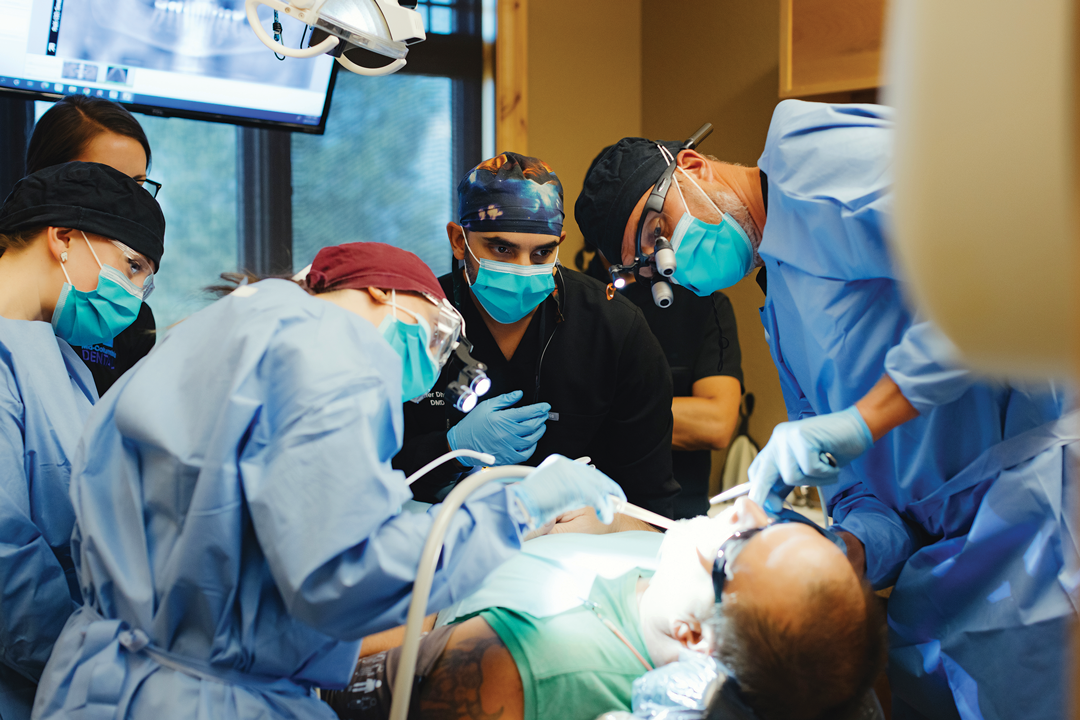The whirr of the drill. The sharp metal thing jabbing your gums and scraping your teeth. The bright lights. Not even Stephen King could make a trip to the dentist sound any scarier.
It’s easy to understand why, according to the Cleveland Clinic, about 36 percent of people in the U.S. are afraid to go to the dentist. And most dentists understand it too.
“Dentistry stimulates all five senses, not always in the best ways, which really explains why it can be so triggering for anxious patients,” says Brooke Kittell, DDS, of Shores Family Dentistry in Fort Collins.
While nobody is making promises that your next dental visit will be something to look forward to, there are more things dentists are doing to help you get over your fears.
One of these things, according to Kittell, is expanded dental training that includes ways to help patients who are dealing with trauma. Trauma-informed dentistry, she says, recognizes that these fears are based on past experiences where patients were hurt or chastised for their own dental care.
“We push empowerment to patients,” she says. “Chairside manner is more important than ever. We try to be gentle and considerate of their space because that is a really vulnerable position.”

Jean Allen, left, beaming with her brand new smile, alongside her daughter.
Talk about trauma
Jean Allen of Rawlins, Wyo., has every reason to be fearful of going to the dentist. In 2018, she was told that due to osteoporosis, she had to have all her teeth removed and replaced with implants. She trusted her local dentist to do the work.
The result was swelling, pain and mismatched teeth that broke often.
“I had night terrors of going to the dentist,” she says. “People don’t understand that fear. But just thinking about it, I was shaking like crazy.”
She refused to see a dentist for four years, even as she endured terrible pain and restless nights, until she saw a TV commercial at 4:30 a.m. from Taher Dhoon, DDM, of Greeley Dental Care. “He said, ‘I can help you,’ and I just started bawling right there on my couch,” she says.
She made an appointment and met with Dhoon. “I just told him to please get me out of this pain,” she says. “He recognized my fears and explained it all.” In the end, all her old implants were removed and replaced with a full set of correctly fitting implants. “He gave me my smile back,” she says.
Dhoon says that while most patients don’t have the kind of trauma Allen had, many still experience some form of trauma when they visit the dentist. For example, some patients need sedation to get X-rays. Just making a phone call to set up an appointment takes incredible courage for those patients. “We have to unwind all of that baggage, and that takes real human connection,” he says.
Some of the trauma people experience comes from their memories of outdated techniques and equipment, according to Dhoon. “For 80 percent of people, we are at a point now that technology and practices are nowhere near as bad as they remember,” he says, adding that procedures that used to take 10 hours can now be done in three. “Things are just better now.”

Brooke Kittell, DDS, of Shores Family Dentistry in Fort Collins.
Coping tips for patients
There are also many things patients can do to reduce anxiety during dental visits.
Bring comfort items. Patients can bring headphones to listen to music or a book, sit under a weighted blanket or use other calming methods, such as aromatherapy, to help manage their nerves, Kittell says.
Ask about sedation. Dentists still use nitrous oxide to help calm patients, if needed, but there are more options these days. Oral sedation and some intravenous drugs can calm patients and help them forget most or all of their memories of the procedure. “A four-hour procedure can feel like 17 minutes, and people just remember it like Polaroid pictures of what happened,” Dhoon says.
Create distractions. Techniques like putting salt on the tongue to avoid a gag reflex are more about distraction than anything else, Dhoon and Kittell agree. Dhoon has found a spot under the chin where a small acupuncture needle stops the gag reflex. “I didn’t believe it at first, but it works,” he says.
Don’t put it off. Kittell says the fear of the cost of a procedure also keeps a lot of patients away, and many are under the impression that dental appointments are costlier than they really are. “It’s so built up in them that they don’t come in and things get worse,” she says. “The first step is just walking in the door.”
Find the right dental office. Kittell says the office can provide clues about a dentist. “Be very observant of how clean the office is, how the team interacts with each other, how much time the doctor gives you and how judged you feel,” she says. “These are great benchmarks to watch for during a new patient exam. The feel of the office can either exacerbate triggers or put patients at ease.”







